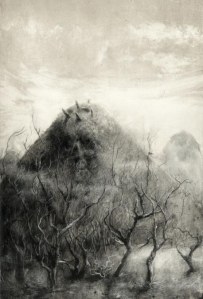The Dunwich Horror (first published in Weird Tales 1929)
by H.P. Lovecraft
The novella begins with a prolonged setup of the Massachusetts town of Dunwich and the surrounding features such as Round Mountain, The Devil’s Hop Yard, and Sentinel Hill atop which a strange ring of stone columns thought to have built by now extinct tribes of Indians. It is perhaps these stones that started the stories of witches and devils that haunt the areas around Dunwich, however, what is know is the general disdain travelers have for loitering in the town any longer than they absolutely have to. The Dunwich folk are mostly composed of but a few families such as the Bishops and the Whatelys. A few of the branches of these familial trees have fallen into degeneration over the decades. It is one such family that story revolves largely around.
Wizard Whately and his albino daughter, Lavina, bizarre and deformed part of the degenerated Whatelys living our at a farm near Dunwich. The xenophobic townsfolk usually take little interest in affairs others, but the birth of Lavina’s son is of note for several reasons. For one, the boy is a bastard with the father unknown by any in Dunwich. Cursorily, Lavina doesn’t shun the boy, but in fact, seem proud of the goatish looking baby. The other oddity is the the boy’s, Wilbur, astonish rate of growth and mental development. By a year and half the boy had grown to the size of a child normally thought to be four. Wilbur began speaking at eleven months seemly skipping lisping and forming sentences almost immediately.
Wizard Whately began odd projects soon after Wilbur’s birth. He found renewed wells of stamina to repair and make additions to his old dilapidated home. Old Whately also began to purchase additional cattle though the surrounding folk noted that his herd size never appeared to increase. For years after none of the people of Dunwich paid this branch of Whatelys any mind as was common for them to mind their business. However, ten years after the birth of Wilbur, the boy who have the appearance and demeanor of a man aided his grandfather in restoring the old barn on the property for some strange purpose. It was later in the spring that old WIzard became worn out and sick. The Whippoorwills had gather in frightening number at the Whately farm. According to Wizard to try an take his soul as he died.
With the death of old Wizard Whately, it was up to Wilbur to finish what sinster task his grandfather has started. To do so required an earlier edition of the Necromonicon written by the Mad-Arab Abdul Alhazred for a passage written on page 751. Wilbur writes many universities and even visits Arkham’s own Miskatonic University to get his hands on own. It only by Dr. Henry Armitage’s refusal that the boy is unable to get the required knowledge from the book. Yet something urgent is requiring Wilbur to return to home…
The Dunwich Horror is a departure from Lovecraft’s normal first person narrative. Although, the author doesn’t stray that far from it. The story is still told in a typical account style writing that gives feels like Lovecraft wanted to have it told from single source (such as a newspaper reporter) but could make all the elements he wanted fit. This does allow the story to give the reader information and immediate tension not usually found in his story. Because the story isn’t written after the fact, the climax can actually generate a more visceral experience that typically found in H.P. Lovecraft. Not withstanding first short chapter, the Dunwich Horror has an easier narrative for readers new to H.P. Lovecraft to follow.
Bottomline: The Dunwich Horror is one of my top five favorite Lovecraft tales. It makes a good entry into reading the author as the story is about villains trying to bring about the end the world and academicians attempting to stop them. Six out of six elder signs to keep the gate and the key of Yog-Sothoth sealed away.


The story is one of my favourite works by HPL, along with “The Horror at Red Hook”.